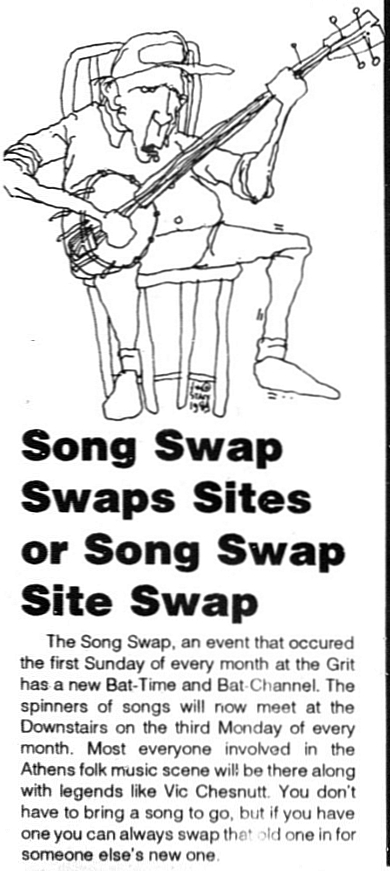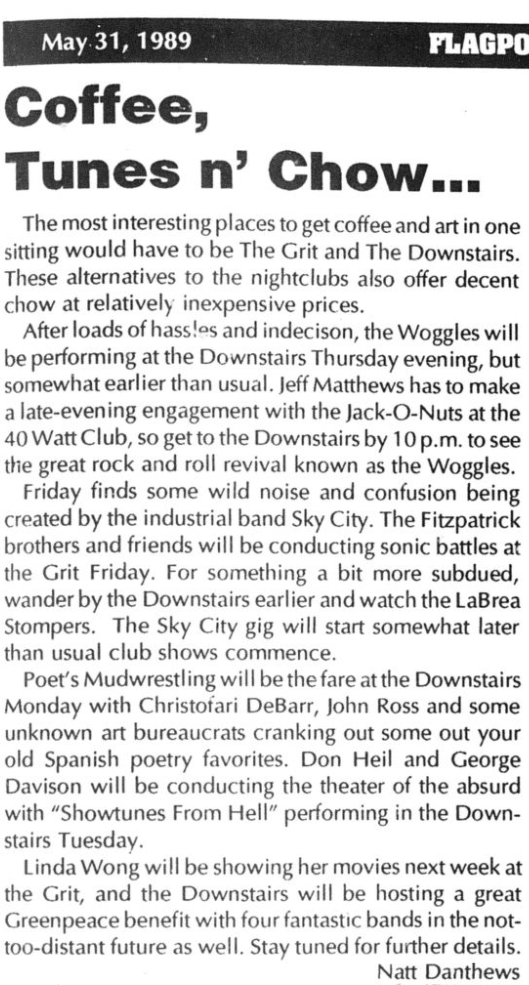A Station That Left the Tracks
Written by our friends at Athens Heritage Room.
T. K. Harty’s Saloon, mentioned in our articles here and at innumerable other retrospective accounts of recent Athens history, was found at what was generally known as the Station. More exactly, T. K. Harty’s was the longest-running business in one of two buildings (plus a train car) located at the intersection of Hull and Hoyt streets. The entire complex, however, should not be confused with the restaurant, the Station, housed in the second of those buildings.
Perhaps another way of looking at it will help clarify this confusing bundle of information. T. K. Harty’s and a host of other establishments were located in what had been the freight terminal of a railroad station. This building was felled by a fire in January, 1995. Thankfully, the rest of the station remains: specifically, the building next door, which housed the passenger terminal, is home now to the Athens Community Council on Aging. The short railway line that ran from this station connected Athens and Lula, a town north of Commerce that served as a stop on the Southern Railway. From Lula, Athenians could travel to Atlanta and points westward or, in the other direction, head up the Atlantic seaboard.
In 1951, Southern Railway shut down its passenger service to Athens. Americans were increasingly turning to their automobiles to travel, with governmental officials often engaging in hidden, high-handed ways of encouraging that particular consumer choice. Even the more popular passenger railway to serve Athens, the Silver Comet run by the Seaboard Air Line Railway, which went directly to Atlanta, would eventually, in 1969, cease operations in Athens. Its local station remains, situated on the dead-end Ware Street, off College Avenue (some old city directories listed its address as 900 College), and occupied now by C. S. X. Transportation, the freight company that runs a considerable portion of the railway lines still in use in the eastern half of the country.
According to an article in the February 14, 1978, edition of the Red and Black, the former train station began to house commercial storefronts by 1972; in other words, the buildings found there entered the post-industrial phase of their history. (Sanborn fire-insurance maps indicate that the passenger depot had been used for warehouse purposes in the intervening years.) T. K. Harty’s set up shop in the freight building, while the former passenger depot became home to the restaurant, the Station.

On that note…. Let us step aside for a moment (in railway lingo, we could say we are taking a branch line) and, looking back at our two-part article on the Last Resort music venue, recall that we quoted articles written by Bill King for the Atlanta Journal-Constitution. King’s coverage of the Atlanta and Athens music scenes for that newspaper was extensive, reflecting his own biography, as a native Athenian who had attended the University of Georgia and then moved to the big city.
T. K. Harty’s Saloon, mentioned in our articles here and at innumerable other retrospective accounts of recent Athens history, was found at what was generally known as the Station. More exactly, T. K. Harty’s was the longest-running business in one of two buildings (plus a train car) located at the intersection of Hull and Hoyt streets. The entire complex, however, should not be confused with the restaurant, the Station, housed in the second of those buildings.
Perhaps another way of looking at it will help clarify this confusing bundle of information. T. K. Harty’s and a host of other establishments were located in what had been the freight terminal of a railroad station. This building was felled by a fire in January, 1995. Thankfully, the rest of the station remains: specifically, the building next door, which housed the passenger terminal, is home now to the Athens Community Council on Aging. The short railway line that ran from this station connected Athens and Lula, a town north of Commerce that served as a stop on the Southern Railway. From Lula, Athenians could travel to Atlanta and points westward or, in the other direction, head up the Atlantic seaboard.
In 1951, Southern Railway shut down its passenger service to Athens. Americans were increasingly turning to their automobiles to travel, with governmental officials often engaging in hidden, high-handed ways of encouraging that particular consumer choice. Even the more popular passenger railway to serve Athens, the Silver Comet run by the Seaboard Air Line Railway, which went directly to Atlanta, would eventually, in 1969, cease operations in Athens. Its local station remains, situated on the dead-end Ware Street, off College Avenue (some old city directories listed its address as 900 College), and occupied now by C. S. X. Transportation, the freight company that runs a considerable portion of the railway lines still in use in the eastern half of the country.
According to an article in the February 14, 1978, edition of the Red and Black, the former train station began to house commercial storefronts by 1972; in other words, the buildings found there entered the post-industrial phase of their history. (Sanborn fire-insurance maps indicate that the passenger depot had been used for warehouse purposes in the intervening years.) T. K. Harty’s set up shop in the freight building, while the former passenger depot became home to the restaurant, the Station.

On that note…. Let us step aside for a moment (in railway lingo, we could say we are taking a branch line) and, looking back at our two-part article on the Last Resort music venue, recall that we quoted articles written by Bill King for the Atlanta Journal-Constitution. King’s coverage of the Atlanta and Athens music scenes for that newspaper was extensive, reflecting his own biography, as a native Athenian who had attended the University of Georgia and then moved to the big city.https://c0.pubmine.com/sf/0.0.3/html/safeframe.htmlREPORT THIS AD
In recent years, upon semi-retiring from the “AJC” and accompanying his work for Dawg Nation, King has written on a variety of subjects at his personal blog, not least Athens history. Of especial significance for Athens history buffs, and our topic here, is his article “Station to Station: Romance of the Rails.” It relates much of what you need to know about the Station restaurant, not least that it was considered to Athens’ fanciest restaurant, the right spot for formal occasions. While in retrospect one may hear more about T. K. Harty’s, at the time, the Station, the restaurant, and the Station, the complex of buildings that once comprised a railway station, shared a name perhaps because the restaurant was for many the primary destination. Presumably, some customers got drinks and listened to music at the Saloon after their dinner.
Of course, another reason why we have heard more about T. K. Harty’s in the years since is, first, its owner being murdered, the tragic culmination of a feud with the owner of Somebody’s Pizza, another restaurant located at the Station; and, second, despite this turmoil, its remaining open until roughly 1990. In one of its last hurrahs, the Saloon and other businesses located at the Station hosted the Fun It/ Sun It Music Festival. The following Flagpole article from its April 18, 1990, issue provides the details.

Elements of the new Athens music scene also made their mark at this most-northwestward part of downtown. The original version of the Grit was located in the freight building, more of a coffee house and performance venue than the vegetarian restaurant it strictly became when it moved to its current location on Prince Avenue. The Grit’s informal setting was similar to that of the Downstairs, originally more of a coffee house and restaurant before becoming known primarily as a performance venue, located in the same period in the basement of 140 East Clayton Street (later D T’s Down Under). Both provided an ideal space in which young artists could workshop their ideas. Among these was no less than the late Vic Chesnutt, one of the most acclaimed of the Athens scene’s music artists. The following brief note from the Flagpole of October 11, 1989, announces the monthly Song Swamp at which Chesnutt and others performed moving from the Grit to the Downstairs.

Another Flagpole piece, seen below (from the May 31, 1989, issue), compares the two establishments, providing snapshots of the kind of goings-on that would make them so crucial to defining an era of Athens music. For more about the Downstairs and the Grit, read Grace Elizabeth Hale’s recent history of the Athens scene, Cool Town.

By late 1991, T. K. Harty’s had switched to the simpler-named Hoyt Street Station. In turn, this operation morphed into two distinct venues, the not-simply-named Hoyt Street Nation North and the Hoyt Street Station Saloon. An advertisement from the March 3, 1993, edition of Flagpole gives an impression of what one could hear at these venues.

Both venues had closed by the time the 1995 fire broke out, apparently caused by persons using the vacant building as makeshift shelter, as explained in these notes found in the January 11, 1995, Red and Black and the January 12, 1995, Athens Observer.


The passenger depot, meanwhile, according to a Red and Black article (January 22, 1988) about a small fire that broke out there in 1988 (foreshadowing the eventual fate of the building next door), was not in use after 1980.

However, that date is slightly off: searching through the Red and Black back issues at Georgia Historic Newspapers, one finds information about the restaurant, Station Masters, which opened in 1980, replacing the Station, and lasted at least until early 1982. Either way, by 1987, the building had been donated to the Athens Community Council on Aging, who eventually renovated the building.
An abundance of resources about U. S. railroad history awaits the researcher online. The title of Streamliner Schedules is self-explanatory. It includes information about the Seaboard Air Line Railroad’s Silver Comet, for example a schedule for May 18, 1947, and other lines that served Athens.
American Rails includes histories of Seaboard, the Southern Railway, and the Central of Georgia Railway, which ran a line from Athens to Macon. And there’s the Southern Railway Historical Association.
Finally, the other articles at King’s blog about Athens history are mostly University-related, with one major exception that we think many Heritage Room regulars would enjoy: an extensive piece about the Varsity: “What’ll Ya Have: More Memories of the Varsity in Athens,” which follows upon an earlier article that appeared in the Atlanta Journal-Constitution: “Growing Up in Athens, the Varsity’s Other Hometown.”

